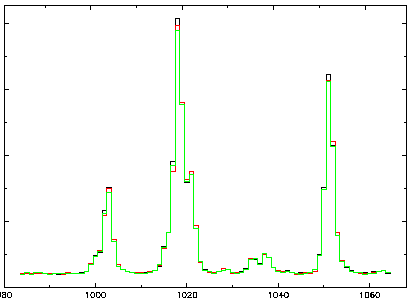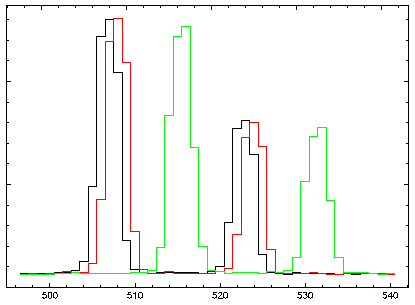Gratings
| No. |
grooves |
blaze angle |
blaze |
recommended application |
efficiency curv |
| 1. order |
range |
order |
channel |
dispersion |
| [lines/mm] |
[degrees] |
[Å] |
[Å] |
[Å/mm] |
[Å/pix] |
| T01 |
830 |
19 |
7700 |
6000-10000 |
1 |
red |
52 |
0.78 |
Plot |
| 3200-5000 |
2 |
blue |
26 |
0.39 |
| T03 |
600 |
17 |
9500 |
7500-11000 |
1 |
red |
72 |
1.08 |
|
| 3800-5500 |
2 |
blue |
36 |
0.54 |
| T04 |
600 |
13 |
7100 |
5500-9000 |
1 |
red |
72 |
1.08 |
Plot |
| 3200-4500 |
2 |
blue |
36 |
0.54 |
| T05 |
1200 |
17 |
4700 |
3700-6500 |
1 |
blue |
36 |
0.54 |
Plot |
| T06 |
1200 |
26 |
7100 |
5500-9000 |
1 |
red |
36 |
0.54 |
Plot |
| 3200-4300 |
2 |
blue |
18 |
0.27 |
| T07 |
400 |
9 |
8000 |
5500-11000 |
1 |
red |
108 |
1.62 |
Plot |
| 3300-5000 |
2 |
blue |
54 |
0.81 |
| T08 |
600 |
9 |
4700 |
3500-6500 |
1 |
blue |
72 |
1.08 |
Plot |
| T09 |
600 |
22 |
12000 |
8400-11000 |
1 |
red |
72 |
1.08 |
Plot |
| 5500-7500 |
2 |
red |
36 |
0.54 |
| 3500-4500 |
3 |
blue |
24 |
0.36 |
| T10 |
830 |
30 |
11500 |
8400-11000 |
1 |
red |
52 |
0.78 |
Plot |
| 5500-7000 |
2 |
red |
26 |
0.39 |
| 4500-5500 |
2 |
blue |
26 |
0.39 |
| T11 |
270 |
5 |
7200 |
5500-11000 |
1 |
red |
160 |
2.40 |
|
| 3200-4500 |
2 |
blue |
80 |
1.20 |
| T12 |
600 |
7 |
3800 |
3100-4800 |
1 |
blue |
72 |
1.08 |
Plot |
| T13 |
300 |
4 |
4700 |
3500-5500 |
1 |
blue |
144 |
2.16 |
|
| 5500-7000 |
1 |
red |
144 |
2.16 |
In order to test how precise is Twin in recovering the wavelength positions
on the CCD, it's say how precise is rotating the gratings, we took a
sequence of comparison lamp frames changing for and back the central
wavelength. After measuring the position of several lines in every frame
with the same central wavelength, we found that the blue arm recover the
position of any line with a precision better than 0.1 pixel.
But the red arm show an error of several pixels when trying to come back
to a previous position. We must study this effect deeply and try to improbe
the grating rotation.
Some examples are shown :
Blue Arm
 Red Arm
Red Arm

Santos Pedraz Marcos
Last modified: Jan 20 2001


